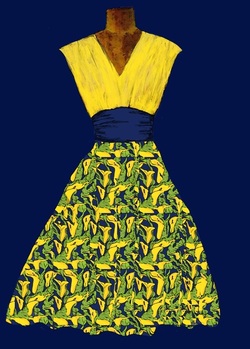 Lane’s wartime sense of fashion would have made her ideal for the life-style she adopted in her new home in the interior of post war British Columbia. While as an older teenager at university before the war, she would have had practical clothing allowing her to get about on a bicycle, women’s fashion was in the grip of a very soft feminine style; longer flowing skirts, gently ruffled sleeves, elegant hats. There was a sense of generosity in the amount of fabric, and the details of buttons, collars and pleats. Lane, like other girls of her class, would have had a wardrobe of fashionable, graceful dresses, and her trousers would have been of soft wool, and generously cut.
Lane’s wartime sense of fashion would have made her ideal for the life-style she adopted in her new home in the interior of post war British Columbia. While as an older teenager at university before the war, she would have had practical clothing allowing her to get about on a bicycle, women’s fashion was in the grip of a very soft feminine style; longer flowing skirts, gently ruffled sleeves, elegant hats. There was a sense of generosity in the amount of fabric, and the details of buttons, collars and pleats. Lane, like other girls of her class, would have had a wardrobe of fashionable, graceful dresses, and her trousers would have been of soft wool, and generously cut.
The minute the war started, she was pressed into the war effort like many multilingual and intelligent students at university, and she would have become one of the almost 1/3 of Britons in some type of uniform. The rationing of cloth during the war had a profound effect on fashion, as skirts became shorter, generous details limited by the number of allowable pockets and buttons, and clothing for women went from generous to practical. They needed to be able to move around freely and have sturdy clothing for the work many of them found themselves doing outside their home, and for many way outside what was comfortable and familiar.
In her new home practical clothing, trousers, and in the summer shorts, and short sleeved shirts would have been the norm. Women were adjured during the war to “make do and mend” and Lane, who likely spent most of the war in uniform, except for when she was undercover in France, still loved beautiful clothing. Like many women, she took her pre-war clothing and adapted it. The calla lily sundress she wears to lunch at her new friends, the Bertollis, is described as having been updated. She has shortened it and removed the generous capped sleeves of the 1930s to make a sleeveless dress that would be considered fashionable today.
I am indebted to From Rationing to Ravishing, The Transformation of Women’s Fashion in the 1940’s & 50’s a publication by the Museum of Vancouver for the fascinating information about the changing styles for women coming out of the war. and to Terry Miller for the art in this and other posts.